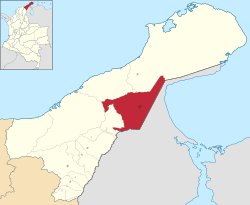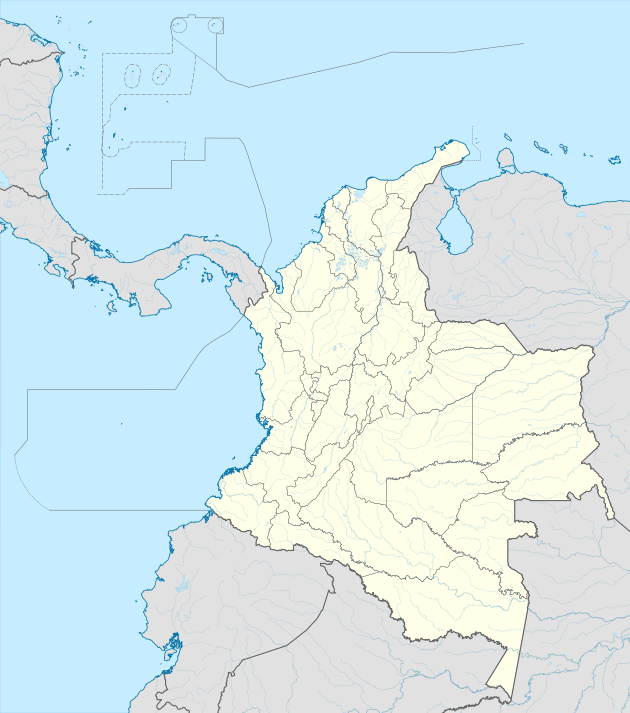Maicao
Maicao (Wayuunaiki: mai-ka-u) is a city and municipality in the Department of La Guajira, northern Republic of Colombia. It is located 76 km from Riohacha, the capital of the department and is the second largest urban center near the border with Venezuela, after the city of Cúcuta.
Maicao | |
|---|---|
city | |
 | |
 Flag  Seal | |
 Location of the town and municipality of Maicao in the Department of La Guajira. | |
 Maicao Location of the town and municipality of Maicao in the Department of La Guajira. | |
| Coordinates: 11°22′40″N 72°14′29″W | |
| Country | Colombia |
| Region | Caribbean |
| Department | La Guajira |
| Foundation | June 27, 1927 |
| Government | |
| • Mayor | Mohamad Jaafar Dasuki Haaj |
| Area | |
| • Total | 1,782 km2 (688 sq mi) |
| Elevation | 52 m (171 ft) |
| Population (2019 est.[1]) | |
| • Total | 166,603 |
| • Density | 93/km2 (240/sq mi) |
| Demonym(s) | Maicaeros |
| Time zone | UTC-5 |
| Area code(s) | 57 + 5 |
| Climate | Aw |
| Website | Official website (in Spanish) |
| * | |
The city was founded on June 27, 1927 by Colonel Rodolfo Morales and Tomás Curvelo Iguarán, on behalf of the Department of Magdalena in the middle of the Wayuu people territory.[2] During the 1970s Maicao became a commercial hub due to an oil boom in Venezuela and the flow of contraband present in the Guajira peninsula.
Geography
Maicao is located in the Guajira Peninsula, the northernmost part of South America and within the Guajira desert.
The municipality of Maicao borders to the north with the municipalities of Uribia and Manaure; to the east with the Venezuela; to the south with the municipality of Albania and to the west with the municipality of Riohacha covering a total area of 1,782 km² and at altitude over sea level of 52 m.
Climate
Climate in the municipality of Maicao is arid, presenting two rainy seasons and two dry seasons. The average temperature throughout the year is of 29 °C (84 °F).
History
Maicao was inhabited by the Wayuu people prior to the arrival of the Spanish. The Wayuu gave strong resistance to the Spanish conquest, remaining rebellious until the early 20th century. Maicao was officially founded on June 27, 1927 by Colonel Rodolfo Morales and Tomás Curvelo Iguarán, on behalf of the Department of Magdalena in the middle of the Wayuu people territory.[2]
The indigenous Wayuu managed contraband trading routes through Maicao arriving from Aruba, Curaçao, Venezuela and other Caribbean sea territories mostly coffee, alcohol, tobacco and weapons among other taxable articles. During the 1970s Maicao became a commercial hub due to an oil boom in Venezuela and the flow of contraband present in the Guajira peninsula. The commercial boom attracted Arab and other Middle Eastern immigrants most of whom established in Maicao as merchants, establishing another culture in the area.
Colombian armed conflict period
The marijuana bonanza in the outskirts of the Sierra Nevada de Santa Marta mountains also introduced another factor to the culture of the region. Marimberos or drug dealers initiated exports of numerous illegal drug trade to the United States and Europe where there was a high demand for drugs. Opulence in certain urban areas became notable, including a Ferraris collection by Lafaurie-González clan (Eduardo, Iván and Fernando Lafaurie-Gonzalez) and their bunker style houses in Maicao and Riohacha.[4]
During the 1980s and 1990s the internal Colombian armed conflict between the government of Colombia and numerous revolutionary groups mainly the Revolutionary Armed Forces of Colombia (FARC) and the National Liberation Army began to affect the municipality of Maicao. Extortions, kidnappings and assassinations became a common practice. The situation worsened due to the deflation of the Venezuelan economy and the trade decrease, as well as crackdowns on contraband by the Colombian government.
In 1991 was given special customs status in 1991 in order to spur job growth. The government's intent was to allow raw materials to enter the zone untaxed, have workers there turn them into finished product, and then re-export the finished goods outside Colombia. The law allowed for a certain amount of goods to pass from Maicao into the Colombian interior, but only if they were declared to customs officials and duty was paid on them. Cigarettes however moved outside the Maicao special customs zone "duty not paid" and from there into the black market.
In 1997 these Middle Eastern immigrants built the Mosque of Omar Ibn Al-Jattab, one of the largest mosques in Latin America.
Maicao became subject to royalties coming from the exploitation of coal in the Cerrejon coal mine, however municipal administrations have been subject to widespread corruption and royalties have been temporarily suspended. The culture of avoiding paying taxes has created in numerous occasions tensions between the locals and the government, including burning down the local tax bureau office DIAN in protest for confiscating large amounts of contraband. The municipality also suffered a problem of displaced people due to the internal armed conflict and deficiencies in education and health.[5]
On March 19, 2000 the town of Albania segregated some 425 km² from Maicao and becoming a municipality. The municipality of Maicao lost a large area over the coal mine section decreasing the royalties percentage intended for the region.[5][6]
Hezbollah ties
According to FBI investigators who allegedly told Rio de Janeiro's O Globo in late October 2001 that in addition to the Triborder Region, a focal point of terrorism in South America was Maicao, described as an Islamic community of approximately 4,670 vacation spot for orthodox Islamics and the largest and best organized Islamic community in Colombia with a minority Shiites reportedly more closely associated with the Muslim fundamentalist concept.[7] The report said that there were cells of the radical group Hezbollah and that it controlled up to 70 percent of the local commerce. "The merchants from there make contributions equivalent to 10 percent and even up to 30 percent of their profits. And those responsible for the fund send the money via banks in Maracaibo in Venezuela, and in Panama.[7]
The Department of Administrative Security (Departamento de Seguridad Administrativa―DAS) shut down a clandestine radio station in Maicao on August 15, 1997, for broadcasting Hezbollah propaganda, and a couple of arrests for money laundering, Maicao's Muslim community reportedly has had few contacts with the law. Nevertheless, it is known that the black market for weapons and money laundering in Maicao and neighboring Zulia State in Venezuela is well established.[7]
Culture
- Mosque of Omar Ibn Al-Khattab built in September 1997, is the third largest mosque in Latin America. Although, Colombia is predominantly a Roman Catholic country, the region around Maicao has a large Lebanese migrant population who funded and built the mosque.
Transportation
The municipality of Maicao had one close airstrip, La Majayura Airport, which has been closed, but may reopen.[8] The city is now served by Jorge Isaacs Airport, which is located 40 kilometres (25 mi) in the southwest. It is also still a major transportation hub between Venezuela and Colombia.
Land transportation is served by a two-lane single-road highway, crossing the municipality of Maicao from Rio Hacha towards Venezuela and another from the town of Maicao south towards Valledupar. While much of the trade is legitimate, there is also a great deal of smuggling and contraband.[9]
References
- "Estimaciones de Población 1985 - 2005 y Proyecciones de Población 2005 - 2020 Total Municipal por Área (estimate)". DANE. Retrieved 20 June 2019.
- Maicao: History
- Maicao: Etymology
- (in Spanish) Los Jinetes de la Cocaina: La Mafia en Macondo
- (in Spanish) El Pilon: Las regalías de Maicao by Salomón Kalmanovitz
- (in Spanish) Gobernacion de La Guajira - Albania: generalities Archived 2007-08-13 at the Wayback Machine
- Library of Congress: Federal Research Division; Narcotics Funded Terrorists/Extremist Groups
- (in Spanish) Senate of Colombia: Senador Ballesteros lidera proceso para garantizar reapertura de aeropuerto de Maicao
- http://www.vivatravelguides.com/south-america/colombia/the-guajira-peninsula/maicao/?no_cache=1
External links
- (in Spanish)Maicao Official website
- (in Spanish)Gobernacion de La Guajira - Maicao